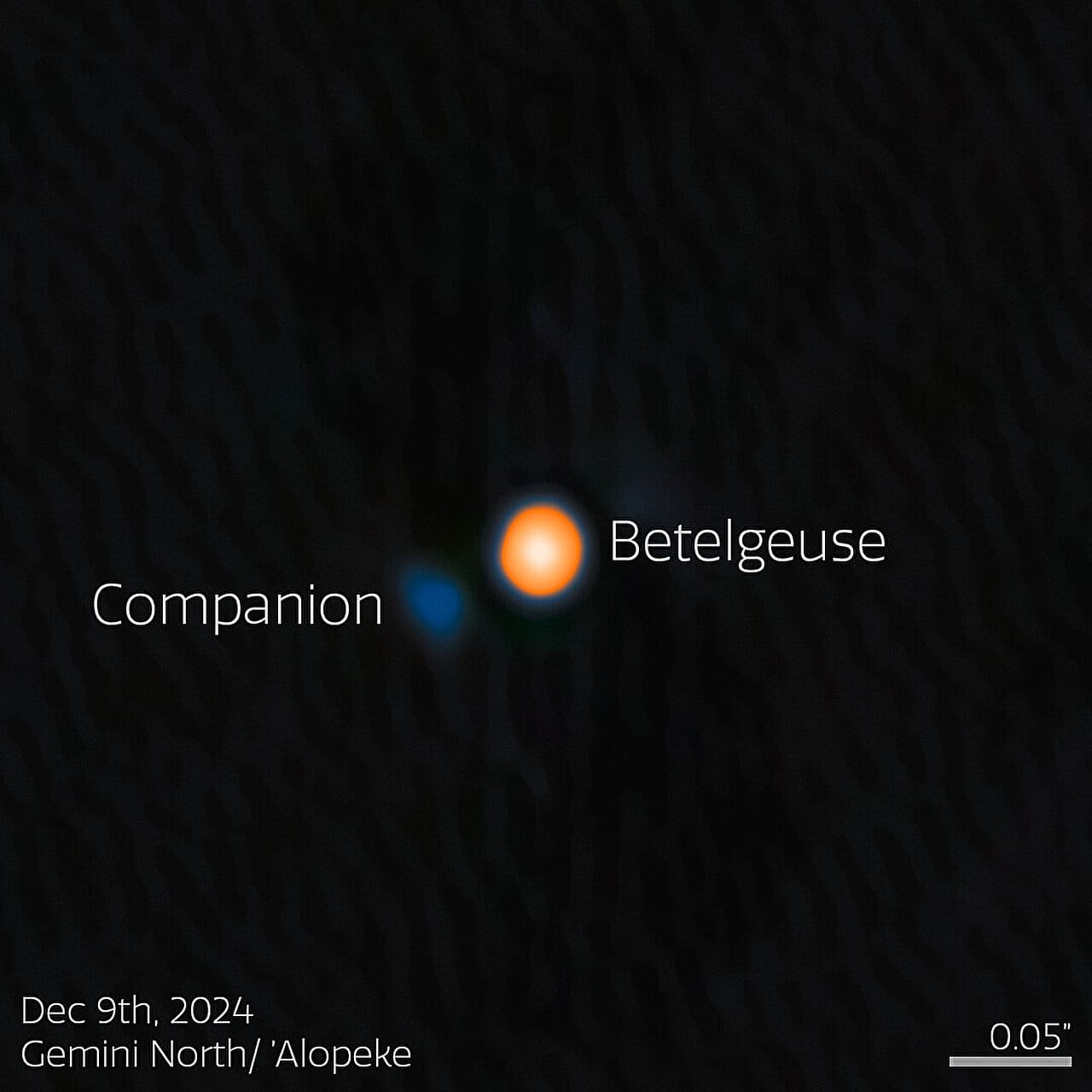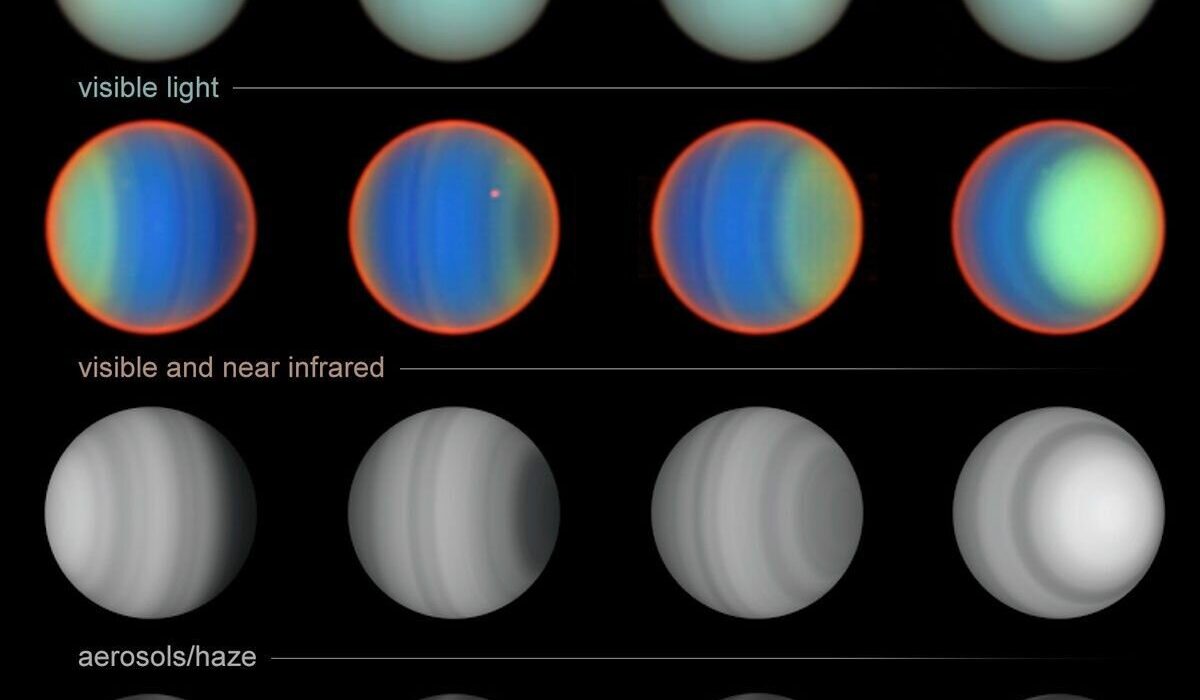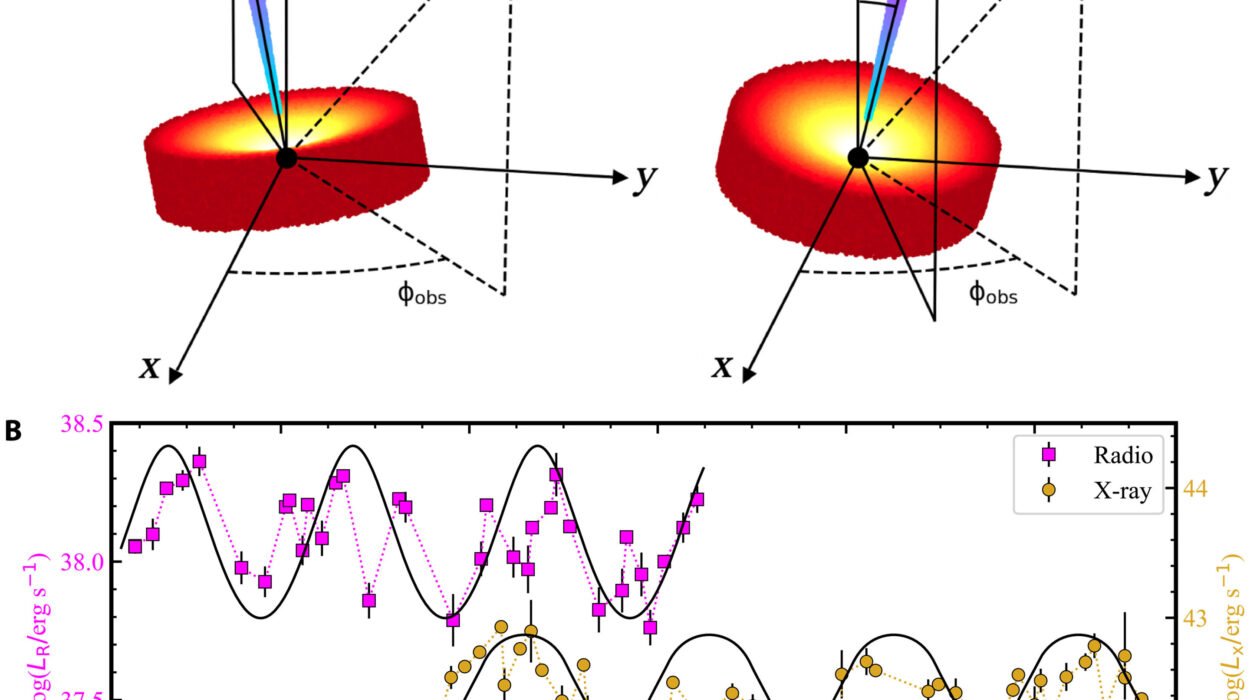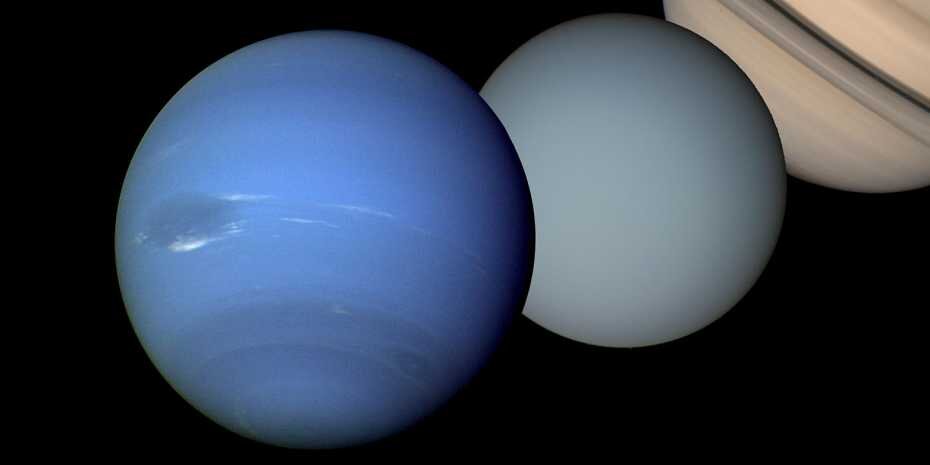For as long as humans have lifted their gaze to the night sky, the fiery red gleam of Betelgeuse has watched back. Perched like a sentinel on the shoulder of the constellation Orion, it has blazed in the heavens with a haunting beauty—its brightness flickering subtly over the months and years, its vastness too immense for the human mind to truly grasp.
At roughly 700 times the radius of our sun, Betelgeuse is not just large—it is colossal. If it were placed at the center of our solar system, its surface would stretch past the orbit of Jupiter. And yet, this monster of a star is remarkably young, just ten million years old—a mere infant in the cosmic scale of time. But Betelgeuse is nearing the end of its life. In stellar terms, its fuel is nearly spent. The day it goes supernova is not a question of if, but when.
And still, Betelgeuse holds secrets—secrets it has harbored for centuries in plain view, hidden behind the twinkle of its fading red glow.
The Great Dimming and a Surge of Fear
In late 2019, something strange happened. Betelgeuse began to fade—not subtly, as part of its known cycles, but dramatically. The star, usually one of the ten brightest in the sky, dimmed by almost two-thirds. Astronomers and stargazers alike stared skyward in awe and alarm. Was this it? Was this the moment the great red supergiant would explode in a supernova bright enough to outshine the moon?
The phenomenon became known as the “Great Dimming.” It triggered a worldwide frenzy of observation. Telescopes turned toward Orion. Simulations ran in labs. News outlets speculated. Betelgeuse seemed on the verge of death—and the universe might be about to give Earth a front-row seat to one of its most spectacular shows.
But as the data flowed in, the true cause emerged. The dimming was not the star’s death rattle, but something more nuanced: a massive cloud of dust, cast off by Betelgeuse itself, had temporarily veiled it from view. The star was still alive, still burning, still holding its secrets close.
And in the wake of the Great Dimming, as astronomers turned their instruments back to the star with renewed purpose, a new mystery quietly came into focus—one that had eluded even the most powerful telescopes for decades.
A Ghost in the Glow
Betelgeuse, long studied and observed, had been known to vary in brightness on both short and long timescales. Its main fluctuation rhythm spans about 400 days, a heartbeat written in hydrogen and helium. But there’s another rhythm—slower, quieter, and stranger. A six-year cycle, persistent and unexplained, lurking beneath the surface. Some scientists had wondered: Could Betelgeuse have a companion? A second star orbiting so closely, and hidden so effectively, that its presence had escaped every previous attempt to detect it?
The idea was tantalizing. A companion star could explain the six-year variability. It could reshape our understanding of Betelgeuse’s evolution. But when NASA’s Hubble Space Telescope and the Chandra X-Ray Observatory searched for evidence, the sky offered nothing. No light. No motion. Just the same solitary giant, pulsing as it always had.
Many concluded that if Betelgeuse did have a companion, it would forever remain out of reach. Too dim. Too close. Too buried in the giant’s overwhelming glare.
But then came a breakthrough—delicate, precise, and extraordinary.
The Fox and the Fire
Atop the Mauna Kea summit in Hawaii, the Gemini North telescope—an 8.1-meter giant of human ingenuity—became the tool that would finally peel back the curtain. Armed with a device called ‘Alopeke, a speckle imaging instrument whose name means “fox” in Hawaiian, astronomers took another look.
Speckle imaging is a marvel in itself. Earth’s atmosphere, while precious to life, distorts incoming starlight. Long exposures blur the stars. But by taking hundreds of extremely short exposures and mathematically reconstructing the image, speckle imaging can erase atmospheric turbulence. What emerges is clarity—true, hard, unprecedented clarity.
And in that clarity, for the first time in human history, a faint glimmer beside Betelgeuse was seen. A companion star—dim, blue-white, and circling perilously close to the red supergiant’s swelling surface.
An Unlikely Survivor
Led by senior research scientist Steve Howell at NASA’s Ames Research Center, the team didn’t just glimpse the companion. They studied it. They measured its light, calculated its mass, and traced its character.
This newfound neighbor is around 1.5 times the mass of the sun—not enormous, but still substantial. Its optical brightness is six magnitudes fainter than Betelgeuse, which explains why it had remained hidden for so long. But even more remarkable than its presence is where it is: just four times the Earth-Sun distance from Betelgeuse’s surface. Not only is it orbiting a star hundreds of times larger than the sun, it’s doing so within that star’s outer atmosphere.
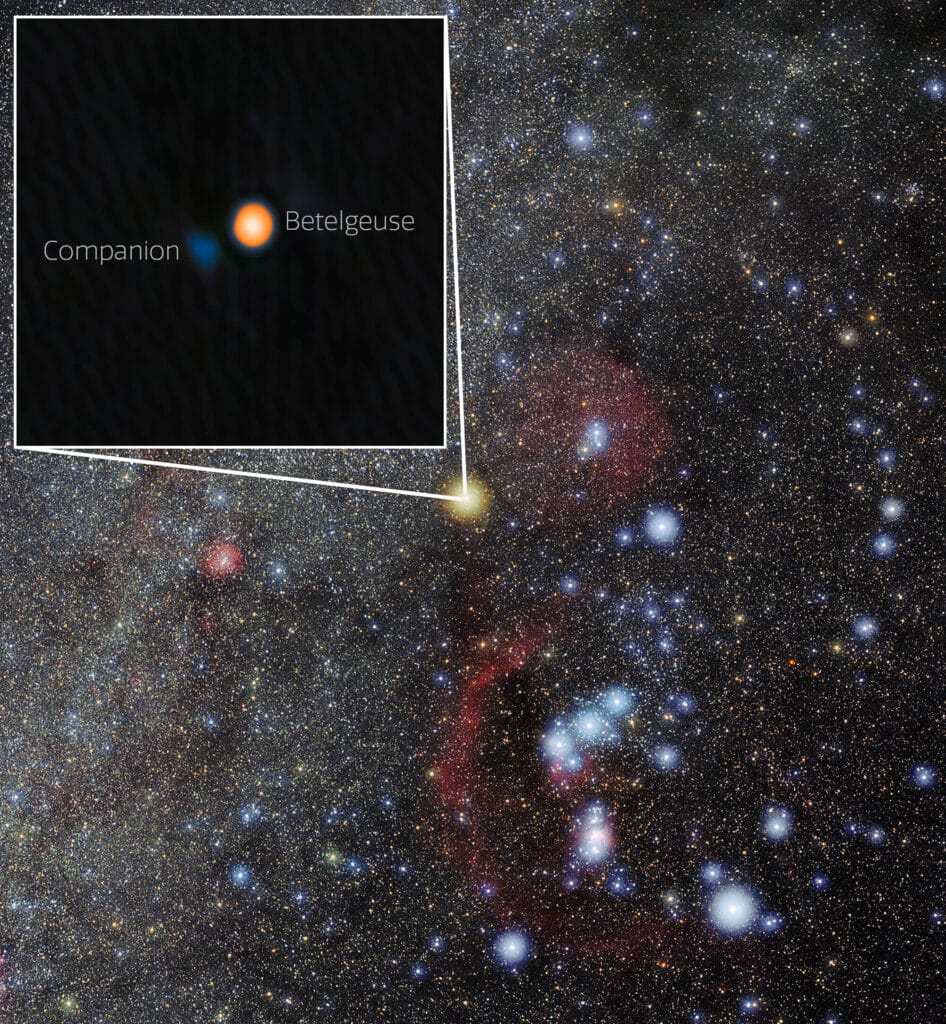
This is the first time a close-in stellar companion has ever been directly detected orbiting a red supergiant. It’s a discovery so precise, so improbable, that until now, it was thought impossible.
The presence of the companion offers powerful new insight into Betelgeuse’s strange light fluctuations. Its gravitational tug and orbital movement likely contribute to the six-year cycle astronomers have puzzled over for decades. Now, the rhythm has a cause—and a face.
A Shared Destiny, and a Tragic One
Betelgeuse and its companion were likely born together, born from the same cosmic nursery millions of years ago. They’ve circled one another across ages of nuclear fire, stars sharing a common origin and a linked fate.
But that fate is not a kind one.
Over time, gravitational forces between the two stars—especially as Betelgeuse continues to swell and evolve—will draw the smaller star inward. Tidal interactions will begin to spiral the companion down, deeper and deeper into the outer atmosphere of its colossal neighbor.
Scientists estimate that in less than 10,000 years—a blink in cosmic time—the companion will be swallowed. It will vanish beneath Betelgeuse’s churning surface, crushed and absorbed in a final, fiery embrace.
And not long after that, Betelgeuse itself will explode in a supernova, casting its light across galaxies and scattering its elements into the void.
A New Frontier in Observation
This incredible discovery does more than resolve a longstanding stellar mystery. It opens the door to something much greater—a new era of observational astronomy.
As Steve Howell notes, “‘Alopeke did what no other telescope has done before.” The ability to directly detect a faint companion star orbiting a swollen supergiant is a technical feat so advanced that past research papers predicted it would never be possible.
Martin Still, program director for the International Gemini Observatory, echoes this sentiment. The capabilities demonstrated by Gemini North and ‘Alopeke represent a transformative leap, delivering answers to questions astronomers have asked for centuries. “Delivering the solution to the Betelgeuse problem that has stood for hundreds of years will stand as an evocative highlight achievement,” he said.
Even more exciting: Betelgeuse’s companion will again reach its furthest separation—its greatest detectability—in November 2027. Observations planned around that time will allow researchers to refine what they now know and, perhaps, uncover more. The fox may have found the star, but the hunt isn’t over yet.
A Star, a Companion, and a Cosmic Drama Still Unfolding
Betelgeuse continues to shine in our night sky, flickering its red pulse across oceans and deserts, across ancient pyramids and modern cities. For millennia it stood alone, a solitary beacon in Orion’s shoulder. But now, we know it never was truly alone.
Its companion—faint, blue-white, loyal—has circled it in silence, hidden in its glow, influencing its rhythm, shaping its fate. Together, they play out a final dance, one star fated to consume the other, both destined to collapse and scatter into the starstuff from which they came.
We look up at Betelgeuse, not just with wonder, but with understanding. Its light carries a story not just of death, but of companionship, of discovery, of the limits of human observation being shattered one photon at a time.
The next time you find Orion rising in the winter sky, pause. Find that flickering red light on his shoulder. And remember: the universe is always deeper than it appears. Sometimes, even the brightest stars have shadows—and sometimes, the faintest glimmers hold the biggest secrets.
Reference: Probable Direct Imaging Discovery of the Stellar Companion to Betelgeuse, The Astrophysical Journal Letters (2025). DOI: 10.3847/2041-8213/adeaaf
